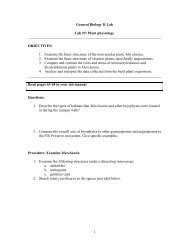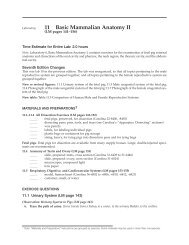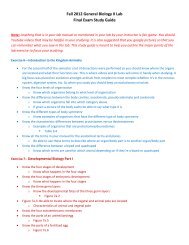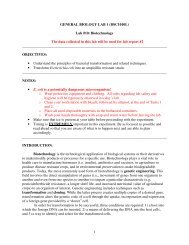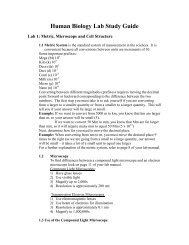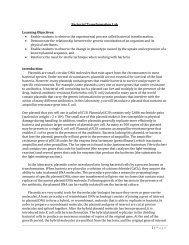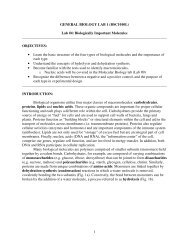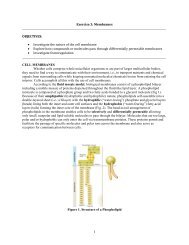GENERAL BIOLOGY LAB 1 (BSC1010L)
GENERAL BIOLOGY LAB 1 (BSC1010L)
GENERAL BIOLOGY LAB 1 (BSC1010L)
Create successful ePaper yourself
Turn your PDF publications into a flip-book with our unique Google optimized e-Paper software.
Important Notes:<br />
• Each group will test the optimal temperature for one amylase type and then<br />
will repeat the experiment using the amylase from the other source. Your<br />
instructor will assign the enzyme that your group should start with.<br />
• At the end of the experiment, your group should have 2 data sets, one for<br />
each type of amylase (fungal and human).<br />
• To determine the optimal temperatures for both enzymes, you will need to<br />
generate a class data set by combining your group’s results with the data<br />
collected by the other groups in your class. These data sets<br />
Procedure:<br />
I. Experimental Setup:<br />
1. Place a napkin/paper under the spot plates (Figure 5) and across the top<br />
write Temperature (0°, 40°, 60°, 95° Celsius) and on the side write Time (0, 2,<br />
4, 6, 8, 10 min).<br />
Figure 5. Spot plate setup<br />
2. Obtain 4 test tubes and label each with a different temperature<br />
(0°, 40°, 60°, 95° Celsius), enzyme source (H – human and F –<br />
fungal) and your group number.<br />
0° - H – Grp1<br />
3. Obtain another 4 test tubes and label these with a different<br />
temperature, enzyme source (H or F), your group number and<br />
the letter S (for starch solution).<br />
4. Add 5mL of 1.5% starch solution into each of the test tubes<br />
labeled S.<br />
II. Effect of Temperature on Amylase Activity<br />
5. Add 1mL of amylase into each of the test tubes that do not<br />
contain starch.<br />
7



